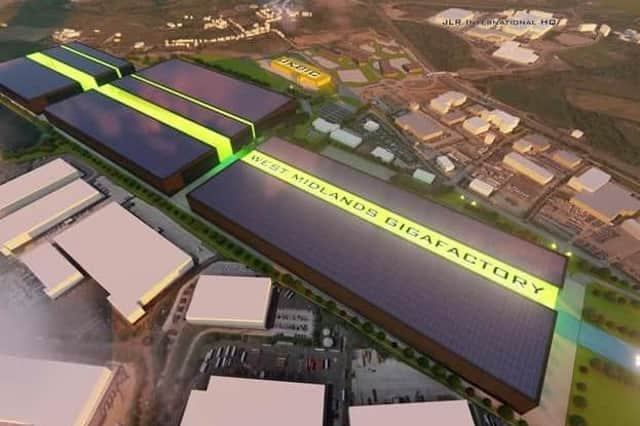Gigafactory plan for Coventry Airport in contention for controversial government scheme


While the headlines have been grabbed by the decisions on tax cuts and borrowing, Warwickshire was revealed to be one of 38 potential sites for a controversial new set-up – labelled as Investment Zones (IZs).
These areas would operate to different standards in a move the government says would attract investment and boost jobs.
Advertisement
Hide AdAdvertisement
Hide AdThe county council, as an upper tier authority, certainly gave a warm welcome to the news the proposed gigafactory at Coventry Airport – in Warwick district – was Warwickshire’s entry on the list but the concept of Investment Zones has sparked alarm from those who see them as setting a dangerous precedent in allowing some parts of the country to operate differently from the rest.
The government’s website explains the principle: “The government envisages that Investment Zones will be one or more specific sites within a Mayoral Combined Authority or Upper Tier Local Authority where a variety of tax, regulatory innovations and flexibilities, and planning simplifications will apply within those site’s boundaries.”
And this introduction also makes clear there are aims beyond business: “There is a strong expectation that Investment Zones will bring forward additional development, and that they bring forward a mix of both commercial and residential development.”
It also leaves no doubt these zones will get special tax benefits and different planning processes from the rest of the county: “When proposals come forward for Investment Zones, they will benefit from a liberalised planning process.”
Advertisement
Hide AdAdvertisement
Hide AdIt adds: “All Investment Zones will have a mandate to boost growth; in zones, the planning system will not stand in the way of investment and development.”
If that sounds like a removal of some of the democratic principles enshrined in our current planning system, the government also opens the door to the zones being run by a separate body: “Where relevant, a development corporation or a dedicated delivery vehicle could be established, providing it does not slow down development.”
This is the point where critics say this puts the scheme firmly into the arena of freeports and charter cities, with chunks of the country being run by operations not subject to the same standards as the rest of the country.
But Warwickshire County Council and Warwick District Council – both Tory councils – only stressed the positives in their original statement on making the list.
Advertisement
Hide AdAdvertisement
Hide AdCllr Izzi Seccombe, leader of the county council, said: “It is wonderful news for Warwickshire and for Coventry that the site of the gigafactory is to be an Investment Zone. The very principles that support these zones are already deep-rooted in the region with our strong talent pipeline, the collaboration between private and public sector and the innovation throughout our enterprises that has driven so much growth in the region in recent years.”
Cllr Andrew Day, leader of Warwick District Council added: “Establishing an Investment Zone is a breakthrough offer from government, which creates a favourable climate to secure the £3.4b in investment needed to deliver the West Midlands Gigafactory.
"This vital new facility will anchor our important automotive and future mobility supply chain, that already supports 50,000 research, development and manufacturing jobs locally, as well and many and many more across the West Midlands. This is just the sort of bold initiative we need to foster the right environment for step-change investment, enabling our net zero economy to flourish.”
This newspaper asked the county council, ‘Could Izzi Seccombe comment on the perspective that the IZs amount to privatisation of parts of Warwickshire and why is she potentially ceding control of these areas from democratically accountable authorities to a private function?’.
Advertisement
Hide AdAdvertisement
Hide AdThe response from a council spokesperson was: “We do not recognise the statement that it will amount to a privatisation of parts of Warwickshire, and not how we see IZs working.”
With the government’s website making it quite clear that the zones would have a different planning regime to areas outside of them, the paper asked for clarification on whether the councils would operate two planning systems or see the zones run by a potentially unaccountable body.
No response was received by deadline but in answer to other questions, the county clarified that many of the details were still to be resolved and that other potential sites in the county could be identified when that guidance was produced.
In terms of a negative impact on areas not inside the new zones, the spokesman said: “Consideration will be paid to any potential displacement of activity to ensure areas not covered are not disadvantaged.”
Advertisement
Hide AdAdvertisement
Hide AdIn terms of how the county came to be included on the list with no apparent forewarning, they added: “Government reached out to a number of local authorities in the week beginning September 19 to explore levels of interest of working with them on this initiative. Conversations were had over that week with Government officials, leading to the inclusion of Warwickshire on the list on Friday.”
There will be further discussions on the gigafactory site in due course and what the county refers to as an expressions of interest process to come.
Further details on the state of play on the principles of the zones, the tax incentives set to be offered for ten years and the way the government want to simplify the planning process, search for Investment Zones on the government’s website.